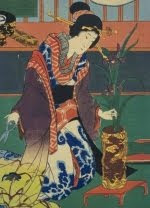A couple of weeks ago the Oslo Chapter of Ikebana International arranged an outing with ikebana work and a visit to a ceramicist studio. The weather turned out wonderful so we could put up our work tables outside. Working facing the water was a great inspiration since we were doing boat arrangements this sunny day.
Going all the way back to the 17th century, Ikebana in boat shaped containers is one of the oldest Seika styles. Since Japan is a nation of islands, ships have always been important in the culture. The ship filled with treasures, Takare-bune, is a well known motive in Japanese mythology. When boat motives are used in ikebana, they are ment to bring good luck to people travelling the Seas.
Cherry blossoms, Clematis, pine.
Home coming boat.
There are essentially two groups of arrangements: Hanging boat arrangements, Tsuri-fune, and standing arrangements, Oki-fune. Traditionally arrangements symbolizing boats at sea are hanging from the ceiling, while boats standing on a shelf or a table are depicting an anchored ship. Since we were working on a table we had to disregard this rule and make all the arrangements standing. We also didn't have enough boat shaped containers, so we played around with painted milk cartons that are kind of the right shape when you lay them flat on the table.
Unknown branches and Forget-me-not.
Boat going home in storm.
By looking at the branches used to depict the mast and sails, you'll be able to read the symbolism of the arrangement. The more the branches are curving, the stronger the wind in the sails. A rather formal seika shape (without strong curves) means it is a ship laying peacefully in the harbor. When the bow of the boat is pointing to the left, it depicts a boat going out, and when it points to the wright it's a boat coming back home. If you are used to the seika style, you'll see that the arrangements are always reversed from what you would expect, so that the shin line can 'bend in the wind', so to say. Also the Hikae (Tai) branch is 'flying', prolonged and swiping elegantly, in a pattern that depicts the rodder of the boat. This is often the longest of the branches.
Please go to this earlier blog post if you want to see a boat lying peacefully in the harbor (click on the text).
Please go to this earlier blog post if you want to see a boat lying peacefully in the harbor (click on the text).
Dry branches of Meadowsweet, Bleeding-heart and pine.
Modern freestyle interpretation of boat laying in harbor.
















2 comments:
I really appreciate all the work you put into posting all this interesting information.
Thank you for sharing your knowledge of this interesting information.
Post a Comment